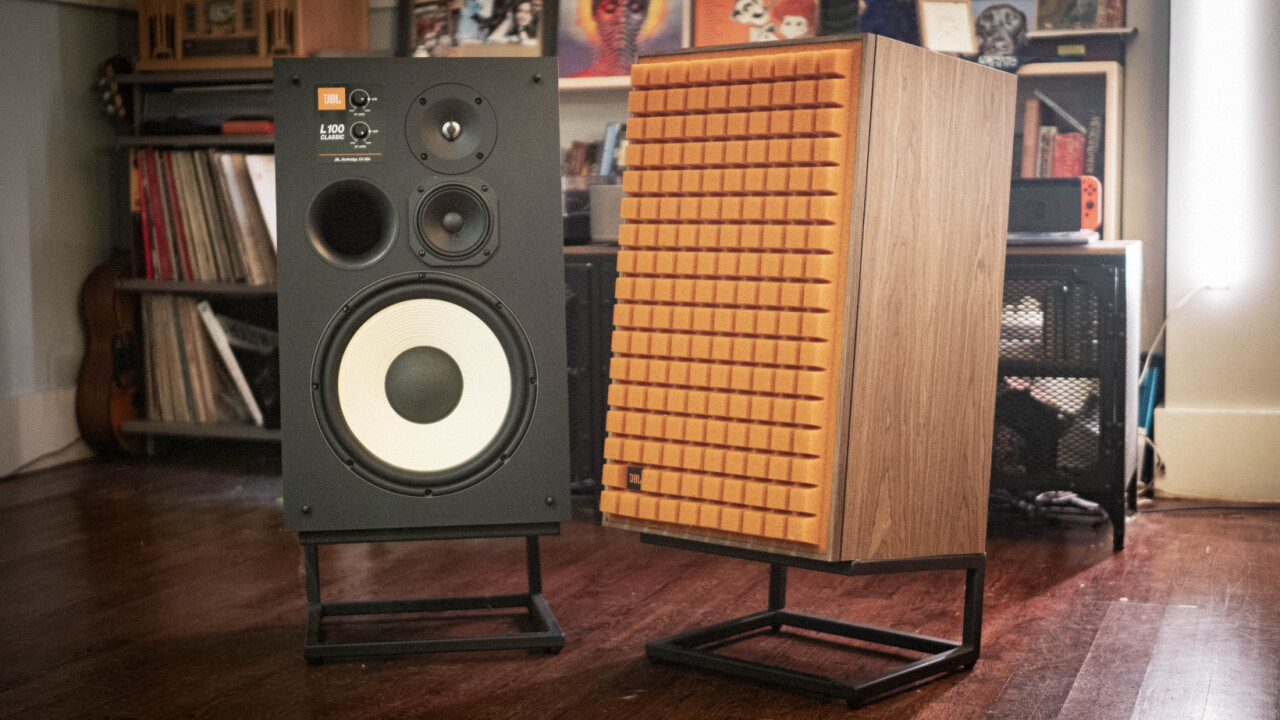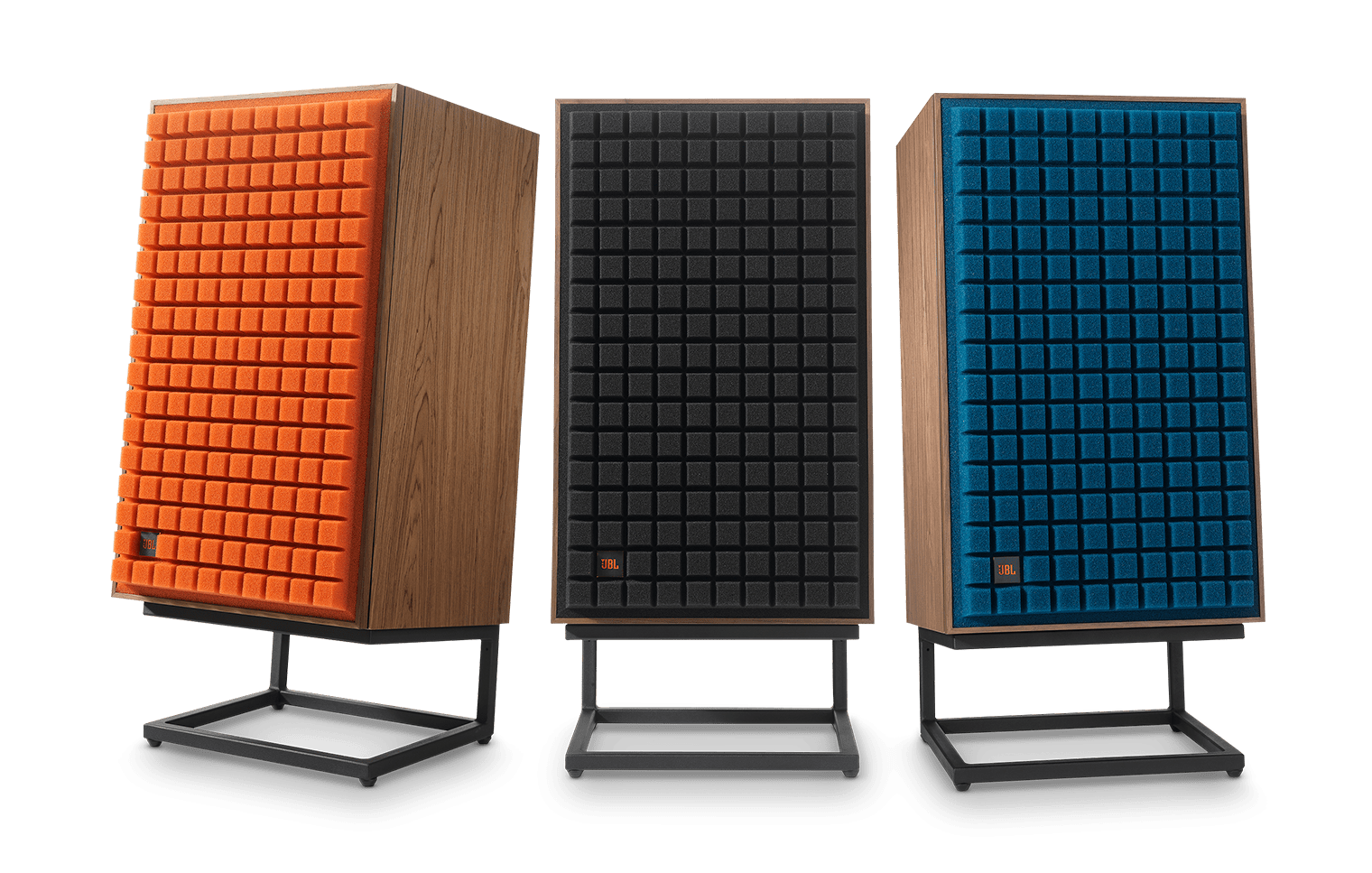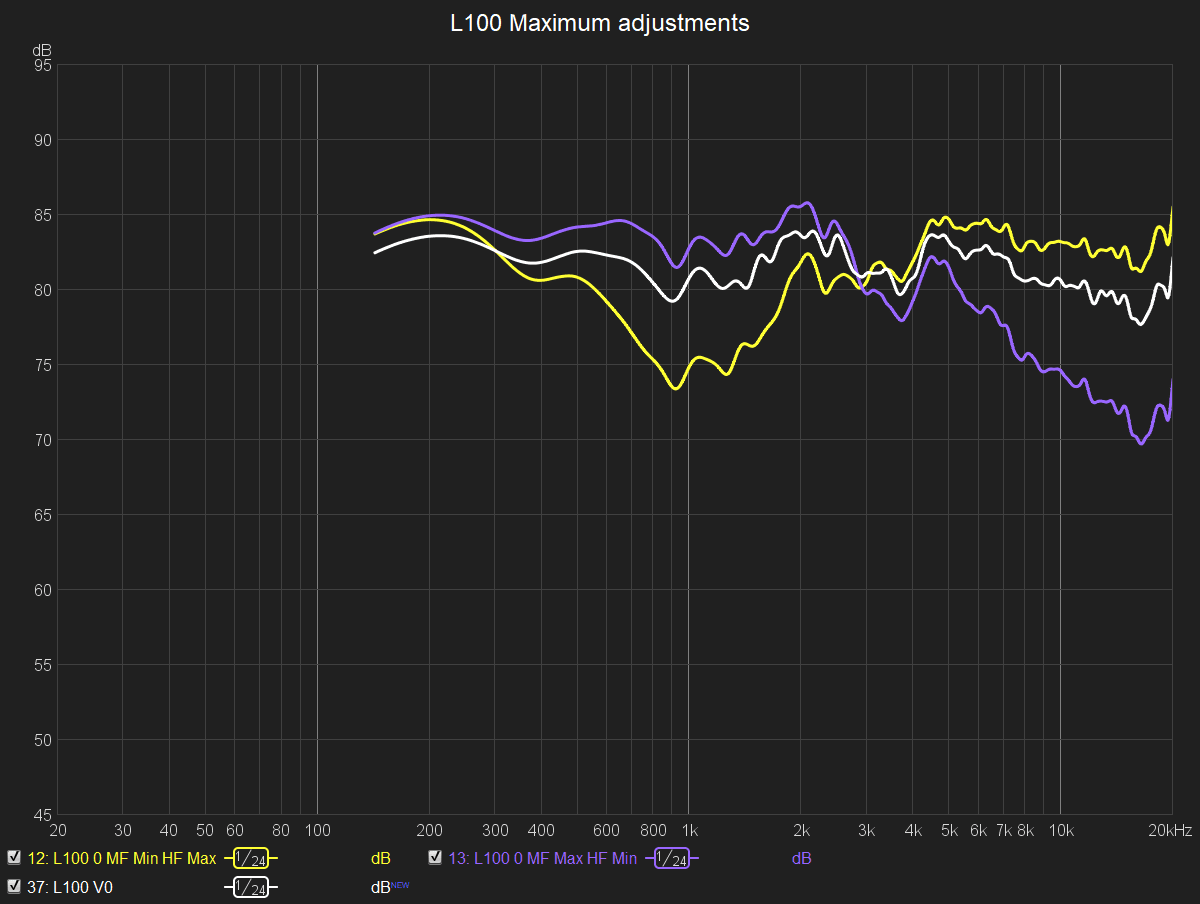
Tell me if this image seems familiar:

Though the ad series – known as ‘Blown Away Guy’ – was meant to sell Maxell cassettes, it’s the speaker blasting the sound that draws your eyes. In the heydays of 70s hi-fi, few speakers were as famous as JBL’s L100. Considered one of the best speakers for rock, and armed a unique waffle-shaped grille in bright colors, it’s no great surprise the L100 was cemented in one of the most iconic audio campaigns of the era.
At least, that’s the lore surrounding the L100. I was born in 1990, so I have no experience with it besides admiring its retro looks at a Goodwill once. When JBL Synthesis – the company’s hi-fi sub-brand – brought the speaker back in 2018 as the L100 Classic, I had my doubts whether the company could justify selling a $4,000 pair of passive retro speakers in a time so full of excellent modern options. Was the L100 Classic just banking on nostalgia, or could it actually be worth the money to audiophiles with no particular affinity for the original?
The answer is patently the latter. The L100 may be retro in its looks, but its enveloping, dynamic, and mostly neutral sound feels right at home among modern hi-fi speakers. The L100 Classic are one of my favorite pairs of speakers to grace my home.
Retro classics
As with any speaker purchase, you need to first get along with the L100’s aesthetic. The big boxy shape is a rarity in a 2019 full of tall, slim towers. I, however, adore the look, even if I’d rather have the blue grilles than the orange ones that came with my unit. Plus, you can use the L100s horizontally if it works better in your space – that’s something you can’t really do with towers.
The speakers feel like quality pieces, with sturdy, 27kg (60lb) frames. An elegant walnut veneer wraps around the sides, while the black-painted front and rear keep up the old-school look.
I normally prefer my speakers with the grille off, but the L100 is a special case. I dig the L100’s triple driver design, especially that majestic 12-inch white woofer, and the controls for mid and high frequencies add some additional retro pizzazz, but I did spend most of my time listening to them with the iconic waffle grilles on.
For one, they add a welcome pop of color in blue or orange, (though there is a staid black option). For another, the grilles are necessary protection for a speaker that sits so low to the ground, at least in my home. The $300 official stands angle the speakers towards your ears, and raise the speakers a few inches off the ground, but they still sit low enough for my dog or cat to damage the paper woofer.

There are some caveats. Considering this is a modernization of the L100, I’d have liked to see some more modern finishes – perhaps a white paint with a lighter wood on the sides would likely fit better in many a modern home that isn’t as hipster-thrifty as my own. It’s also worth noting that the L100’s tweet and woofer are offset from the center, and the speakers aren’t mirrored; that could irk someone persnickety about symmetry. And I really think the stands should be included at this price; they aren’t particularly remarkable and don’t feel worth $300, but are essential to maximizing performance.
Still, those are relatively small complaints. L100’s design is a win in my book.
That ‘live’ sound
With the old school design, it’s easy to assume the speaker isn’t up to modern standards. But if JBL made any meaningful compromises, I cannot hear them.
I had the pleasure of spending several months with the L100s, longer than I meant to (sorry, JBL!). In that time, I rarely wanted to listen through anything else.

A note on setup: The L100’s sound can vary dramatically depending on how the tuning knobs are set – transforming into a completely different speaker at the different ends of the knobs’ range. JBL says their default setting is meant to measure the flattest in an anechoic chamber (something correlated with user preference at home), but the knobs should be set to whatever you think sounds best. For me, that was maxing out the ‘highs’ knob and setting the mids knob halfway between default and max. Coincidentally, this also seemed to deliver the flattest measurements in my own testing, but more on this later.
My initial impression of the L100s was defined by their spatial presentation. The soundstage seemed to come from well beyond the boundaries of the L100’s wide baffles. On multiple occasions, I had to double-check my music wasn’t being upmixed by the Yamaha A3080 receiver powering them. That is to say, the soundstage was so expansive, there were a few times I seriously thought music was playing out of my surround and overhead speakers. I suspect the sense of height is in part due to the upward-firing design, but my frequency response measurements also point to wide dispersion helping.
Vocals are a particular highlight, manifesting into mid-air sources seemingly made of flesh and bone. When listening to musicals like the fantastic Hadestown, it’s easy to imagine yourself in prime Broadway seating, able to place singers not only on the X-axis of the stage, but on the Z as well.
The large woofer might predispose you to expect thumping bass, but it’s surprisingly tasteful on the L100, aiming for extension and transient response rather than sheer quantity (although there’s plenty of that too). The basslines in Janelle Monae’s Make me Feel or Lizzo’s Juice are addictive without being bloated. Acoustic and synthesized bass alike feel snappy, and kick drums have an authoritative, well… kick, to them. The bass is rated to extend down to 40hz (-6db), but in practice, I think the speaker’s low positioning on its stands leads to more bass reinforcement from the floor compared to a ‘normal’ speaker.
That said, the L100 is not a solution for pure bassheads, as the sound errs on the side of accuracy. Though you can get a significantly bassier sound by turning down the mids knob, it’s no replacement for a subwoofer, and can’t compete with an active design like the Bowers & Wilkins Formation Duo on sheer quantity, despite the latter’s far smaller size. For most music, the L100 has just the right amount of bass, but as with the vast majority of passive speakers, it’s missing those last few Hertz so prevalent in some modern music.
The mids and highs are also relatively neutral in their overall tonality, but here the speaker reveals more of its forward character. I suspect part of the reason they sound so good with vocals is a slight emphasis in the upper mids and lower treble, giving voices a bit of an edge that I find enhances intelligibility (handy when doubling as TV speakers). It does this without destroying timbre though; everyone from the deepest bassoprofondos to lyric sopranos are portrayed with a natural tone. There’s plenty of detail too which combined with the standout imaging, makes it easy to pick out individual instruments in complex pieces.
Add to this the fact the L100 are easy to drive and have superb dynamics, and you have a speaker that excels at giving you that ‘live music’ feeling. Audio memory is fickle, but to the best of my recollection, I found it more engaging than the KEF R3, more accurate than the Bowers and Wilkins formation Duo, and competitive with Focal’s $12,000 Kanta No 3 on dynamics. It’s the type of speaker that gives you that musicians-are-actually-playing-in-my-living-room type of sound, and it’s as suited for Sibelius as it is for Deep Purple.
Measurements
We can see some of these qualities come to play in the speaker’s frequency response measurements, taken using a quasi-anechoic method that approximates the results taken in a proper anechoic chamber. As usual, I take listening notes first and measure second, but it’s interesting to see how often measurements line up with my subjective impressions.
Measuring the L100 Classic was tricky, partly for their size and heft, which limited the range of vertical frequencies I could capture, but also because the tuning knobs allow for a wide range of responses. Below, you can see the frequency response with the knobs at their default ‘0 db’ setting as well as with both knobs maxed out. I preferred the latter in my own listening. You can also see how the grille affects sound relative to the default setting.

It’s an overall flat response for a passive design, and research suggests most listeners prefer a flat sound. It’s certainly not the flattest passive speaker I’ve seen in the price range – that honor goes to KEF R3 – but it’s within the boundaries of what I’d consider close to neutral tonality. For reference, the $800 Neumann KH80 is the flattest speaker I’ve tested, a studio monitor which uses digital signal processing to achieve a ruler flat response (my measurements for comparison here).
One would hope for decent performance from a $4,000 speaker, but it’s good to know JBL didn’t ignore good acoustics to make a retro product. It’s also worth remembering that while these measurements describe much of the speaker’s sound, they only part of the story – they don’t capture the L100’s wonderful dynamics, for instance, which are notably superior to the KEFs.
The above graph shows peaks around 2k and 4.5khz that likely help give the L100 it forward character. That said, that 2Khz peak is not as audible as you might think. When seated in the ‘sweet spot’ between two stereo speakers like a proper audiophile, this frequency region tends to be attenuated. I find a slight boost here helps make voices sound more natural. The treble, meanwhile, has a slight downward slope, but if you prefer a brighter sound, this is easily rectified by setting the respective knob to the max setting.
To demonstrate just how much the knobs can affect the sound, here is the frequency response with mids knob at its lowest setting and the highs at maximum, and vice versa. It’s basically enough variation to become a completely different speaker.

More than just a flat direct response though, good speakers tend to distribute good sound off to the sides as well. Much of the sound you hear is actually reflected from your room, so you want the sound emanating from the speaker at odd directions to not be too dissimilar from the sound pointed right at your ears.
To test this, I place the speaker on a large turntable such that it rotates around the tweeter axis. I take measurements at regular intervals to show how the sound changes as you move away from the direct axis. Here’s the horizontal response:

We see that even at extreme horizontal angles, the L100’s frequency response changes smoothly relative to the direct sound, maintaining an overall similar shape. This likely helps give the L100 Classic that expansive soundstage.
Also note how the treble peak at 4.5Khz is tamed by the time you reach 30 degrees off-axis. I’ve found many speakers sound best slightly off-axis, and the L100 is no exception. Indeed, I thought the speakers sounded best pointing straight out or with a slight toe -in, as opposed to aimed right at the listening position for the direct sound. All the better, as this is the more aesthetically pleasing setup in my book.
The ‘Listening Window’ measurement in the center, which captures sound within a ±30-degree horizontal window and a ±10-degree vertical one, takes into account the fact people don’t sit perfectly still and might not be exactly centered between speakers. Here it shows a slightly cleaner response than the on-axis one.
And now for the vertical response:

We do see a large dip once we reach 30 degrees off-axis on the vertical plane, but this is pretty common and the response remains reasonably flat within a ±10-degree vertical listening window. But you do want to make sure the tweeters are at ear level when possible, something the angling on the official stands makes pretty easy.
A modern classic?
The L100 Classic is a beautiful speaker with a well-rounded sound that is mostly neutral, with a bit of a forward character to spice things up. Taken as a whole package, my main complaint about is that in some regards, it feels a bit too retro.
I can’t help but feel that the company could have attracted more young audiophiles with some modern design choices. The aforementioned lighter veneer options or an-all black design, for instance, could help it blend into some listener’s aesthetics.
On the technical side, with such a huge cabinet and massive woofer, I’d love to see what JBL could achieve in an active design with an integrated amp and digital signal processing. This could help even out kinks with the frequency response and allow the bass to reach even lower.

There’s nothing wrong with passive speakers, of course, but considering the ‘Classic’ moniker and the earlier L100’s popularity, such choices might’ve given the L100s further potential to become a modern classic, rather than building off the reputation of its predecessors. A $4,000 price tag also puts it out of the reach of many younger audiophiles, though I think they are well worth the price and comparable to a good set of towers.
But broader thoughts about the state speaker design aside, as far as this specific listener is concerned, the L100 Classics are a modern classic. They excel in soundstage breadth and imaging. They are just a touch forward, their sound is customizable, they have deep bass, and they feature toe-tapping dynamics. The L100 Classics are some of the most enjoyable speakers I’ve had the fortune to listen to, and I’m sad to see them go.
Get the TNW newsletter
Get the most important tech news in your inbox each week.




